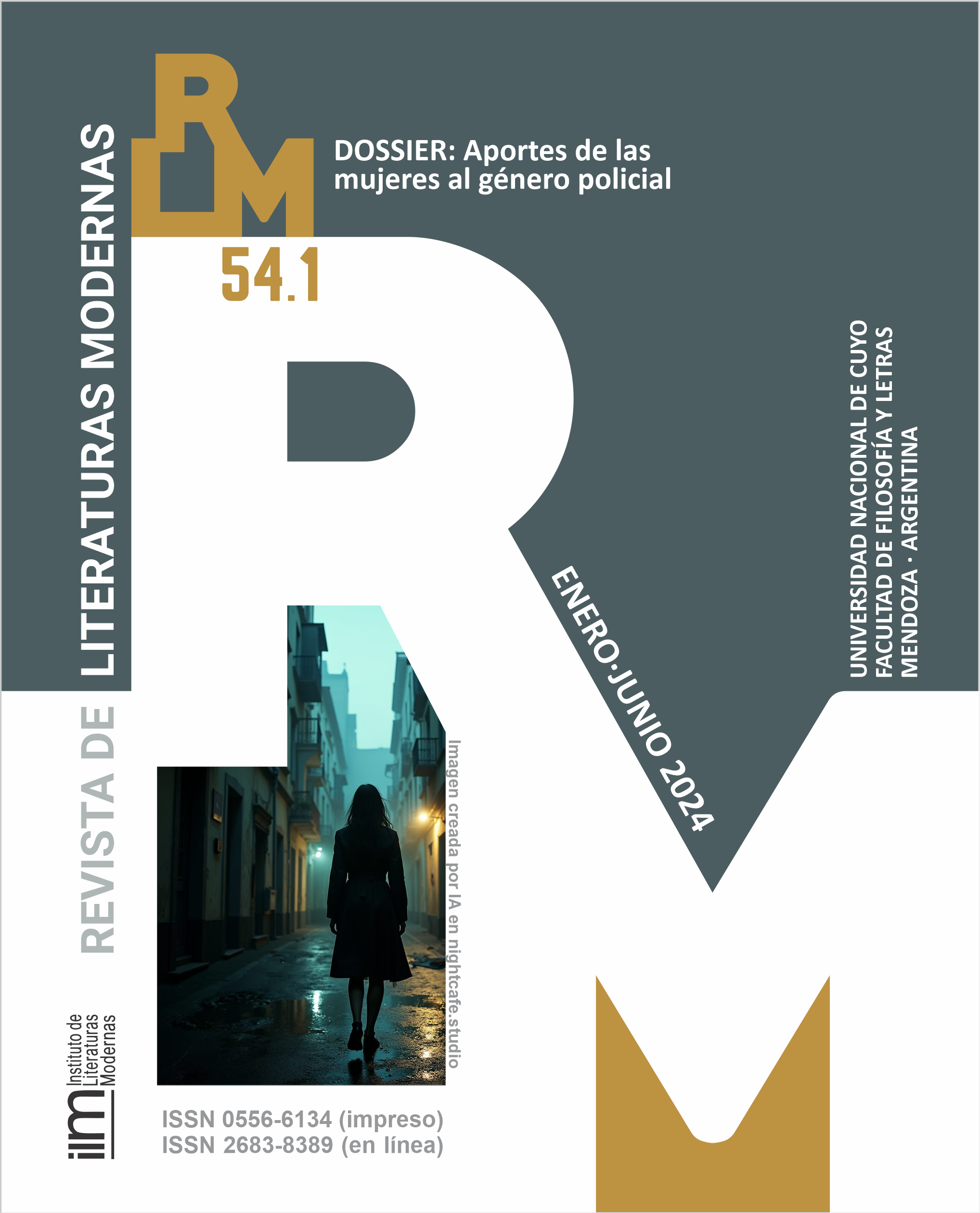La trata de mujeres en la novela criminal escrita por autoras argentinas: "La Varsovia" y "Cornelia"
Palabras clave:
mujeres, trata de blancas, control, víctimas, espacioResumen
El presente trabajo analiza el surgimiento de escritoras argentinas en la novela negra en el nuevo milenio, como es el caso de Patricia Suárez y Florencia Etcheves. Este fenómeno destaca la ruptura con el machismo literario del género policial. Uno de los enfoques de este estudio consiste en la representación de la tiranía sobre las mujeres en los siglos XX y XXI, lo cual evidencia la continuidad de la esclavitud sexual y la violación de los derechos humanos. A través de un análisis comparativo entre las obras de estas autoras, se muestra cómo la opresión y explotación de la mujer persisten a lo largo del tiempo, subrayando la necesidad de supervivencia de las víctimas y los mecanismos de control social que las perpetúan. La Varsovia y Cornelia presentan un universo que resuena en el presente. Así, se confirma la persistencia de estos sistemas de poder con diferentes actores, pero con el constante sufrimiento y vulnerabilidad femenina.
Descargas
Citas
Almada, S. (2015). Chicas muertas. Random House.
Ben, P. (2018). Historia global y prostitución porteña: El fenómeno de la prostitución moderna en Buenos Aires, 1880-1930. REMS - Revista de Estudios Marítimos y Sociales, 5/6, 13-26. https://estudiosmaritimossociales.org/wp-content/uploads/2014/01/rems-nc2ba-5-6-dossier-gc3a9nero-y-clase-ben-1.pdf
Biernat, C. (2016). Entre el abolicionismo y la reglamentación: Prostitución y salud pública en Argentina (1930-1955). Cuadernos del Sur – Historia 40, 29-48. http://hdl.handle.net/11336/68108
Borges, J. L. (2006). Borges Oral. Alianza Editorial.
Cabezón Cámara, G. (2013). Le viste la cara a Dios. Eterna Cadencia Editora.
Cantó, P. (13 de junio de 2019). Etcheves: Si un periodista duda de la víctima de La manada, que se dedique a otra cosa. El confidencial. https://www.elconfidencial.com/cultura/2018-06-13/entrevista-florencia-etcheves-cornelia-libro-feminismo-la-manada_1577849/
Colmeiro, J. F. (1994). La novela policíaca española: teoría e historia crítica. Anthropos.
Daich, D. y Sirimarco, M. (2014). Policía prostitución. Una relación pornográfica (El control de la prostitución en Argentina 1875-1936). Jurídicas, 9(1), 80-100. https://revistasojs.ucaldas.edu.co/ index.php/juridicas/article/view/4919
De los Santos, G. (2016). Chiara Páez, el crimen de la adolescente que disparó las marchas de Ni una menos. La Nación. https://www.lanacion.com.ar/seguridad/rufino-chiara-nid1905389/
Etcheves, F. (2016). Cornelia. Planeta.
Foucault, M. (2002). Vigilar y castigar. Nacimiento de la prisión (1975) (Trad. A. Garzón del Camino). Siglo Veintiuno Editores.
Gigena, D. (7 de febrero de 2016). El nuevo género negro: novela policial con cara de mujer. La Nación. https://www.lanacion.com.ar/cultura/el-nuevo-genero-negro-novela-policial-con-cara-de-mujer-nid1869039/
Giulietti, J. (28 de septiembre de 2015). La trata de blancas en la ciudad de Córdoba en la década de 1930. Academia. https://www.academia.edu/16276174/LA_TRATA_DE_BLANCAS_EN_LA_CIUDAD_DE_C%C3%93RDOBA_EN_LA_DECADA_DE_1930
Guy, D. (1994). El sexo peligroso. La prostitución legal en Buenos Aires 1875-1955 (Trad. M. Egula). Sudamericana.
Hernández, C. y Angueira, L. (2010). Human Trafficking in Puerto Rico: An Invisible Challenge. Universidad de Puerto Rico.
Krimer, M. I. (2015). Sangre Fashion. Aquilina.
La Casa del Encuentro. (s. f.) Informe de investigación de femicidios en Argentina. https://www.lacasadel encuentro.org/femicidios03.html
Miranda, M. A. (2011). Buenos Aires, Entre Eros y Tánatos. La prostitución como amenaza. Scielo España. https://scielo.isciii.es/pdf/dyn/v32n1/05.pdf
Morcillo, S. (3 de mayo de 2021). Marco Teórico y Contexto. TeseoPress. https://www.teseopress.com/ sexopordinero/chapter/marco-teorico-y-contexto/
Orsi, A. (2018). Prostitución reglamentada, moral sexual y familia patriarcal en Junín, Provincia de Buenos Aires (1891-1936). Cuadernos De H Ideas, 12(12), e011. https://doi.org/10.24215/ 23139048e011
Plante, A. (2014). Verde oscuro. Adriana Hidalgo Editora.
Rossi, L. (2013). Baldías. Erizo Editora.
Simonetto, P. (2019). Los rufianes de Buenos Aires: Prácticas de proxenetismo global en la Argentina, 1924-1936. Varia Historia, 35(67), 311-344. https://doi.org/10.1590/0104-87752019000100011
Suárez, P. (2014). La Varsovia (Las Polacas III). CELCIT.
Tiscornia, S. (2014, October 13). Entre el imperio del ‘Estado de Policía’ y los límites del derecho. Seguridad ciudadana y policía. Nueva Sociedad 191, 78-89. https://www.pensamientopenal.com. ar/doctrina/39999-entre-imperio-del-estado-policia-y-limites-del-derecho-seguridad-ciudadana-y-policia
Trochon, Y. (22 de mayo de 2020). La ciudad de los burdeles. Barrio Pichincha. www.barriopichincha.com.ar/la-ciudad-de-los-burdeles/
U. S. Department of State. (29 de marzo de 2019). Informe sobre Trata de Personas 2018. U. S. Department of State. https://2017-2021.state.gov/index.html?_g1=1*dorobv*.gclau*%20MTk2 NDg3ODc2NS4xNzA0Mzg5Mzg3
Descargas
Publicado
Cómo citar
Número
Sección
Licencia

Esta obra está bajo una licencia internacional Creative Commons Atribución-NoComercial-CompartirIgual 4.0.























